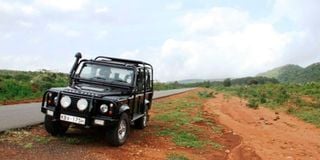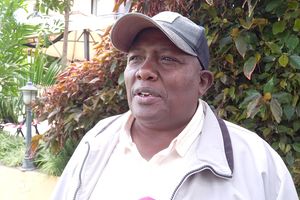Premium
Finding a road less travelled by

Our Defender (son of Mzee) taking a break in Kedong Valley.
When Covid seemed to be fading away, we drove out of Nairobi for a long and relaxing weekend in Masai Mara. On the way back, we didn’t want a repeat of the mindless traffic jams we had suffered on the Escarpment on the way out. Approaching Maai Mahiu and leaving Suswa township, we saw a signpost to Ngong.
I had been on that road before. I was with David Morgan when he was general manager of the Safari Rally in the 1990s. We were exploring a possible rally route through the Loita Hills. The road from Ngong to the junction of the Maai Mahiu to Narok road was really a roughish dirt track. Mind you, in those days, as the New Zealand driver, Possum Bourne, told me, the foreign drivers thought the worst stretch of the rally was not the rocks, the dust or the mud – it was some of the tarmacked non-competitive sections. ‘Those potholes,’ he said, ‘they break cars.’
So, on the trip back from the Mara, we reacted to the signpost near Suswa. However, as soon as we left the main road, we found only a spaghetti of dirt tracks. The people we asked only pointed the way up Mount Suswa. That wasn’t on our agenda.
Anyway, our previous drive up the volcano had been something of an embarrassment. With guests on board, my old Range Rover – Mzee, we called it – had bellied out when I drove along ruts that were too deep. We were rescued by amused Maasai youth.
When later I told my son Andreas about our failure to find the road, he told us that had we persisted we would have found that all of it except the last five kilometres had been tarmacked.
Kedong Valley
Last Sunday, my wife and I decided to go to have a lakeside lunch under the fever trees at the Lake Naivasha Country Club. On the way, we would try that road through the Kedong Valley.
By the way, I’m told that the Kedong Valley is known as a place of skulls. Back in 1895 it was the scene of a massacre. The story is well told in Charles Miller’s The Lunatic Express, which is his very well-written history of the building of the East African railway.
A large caravan was descending into the Rift Valley from Kijabe. The caravan’s Swahili leader ordered the capture of two Maasai girls from a nearby manyatta for his evening entertainment. The Maasai retaliated in a night attack. They wiped out almost all the 871 members of the caravan, the two Swahili leaders, porters and armed escorts.
An English trader, Andrew Dick, took it upon himself to mount a punitive raid on the Maasai. He recruited three bemused French hunters. They rounded up a large number of cattle, but eventually the Maasai struck back. Andrew Dick was killed. Charles Miller doesn’t tell us what happened to the French hunters. A positive sequel was that the British authorities realised that the caravan leaders had started the conflict, and so the Maasai were subjected to only a token fine.
Rescued by Google
… But back to the elusive road. My wife and I drove to Ngong town, took the signposted road to Suswa, missed an un-signposted sharp right turn at Kimuka township, were rescued by Google when we realised if we carried on we would have ended up at Kiserian. Andreas, unlike him, wasn’t wholly right, because there were occasional places that were not tarmacked – difficult rocky spots that must have been left for later solutions. But he was very right about the last five untarmacked kilometres. The dust was so fine. And the heavy lorries working on the road construction were throwing over us huge clouds of it.
If you are tempted to take this Kedong Valley route, unless you have a four-wheel drive vehicle and a high tolerance of dust, I would wait till the work on those last five kilometres is done.
John Fox is managing director of iDC Email: [email protected]





